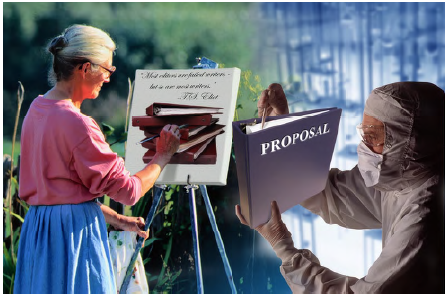
How to Create Great Proposal Themes (Part 3): The Proof is in the Pudding
- 1.How to Create Great Proposal Themes
- 2.What’s a Proposal Theme and Why is it Important? (Part 1)
- 3.How to Create Great Proposal Themes (Part 2): Features and Benefits
- 4.How to Create Great Proposal Themes (Part 3): The Proof is in the Pudding
- 5.How to Create Great Proposal Themes (Part 4): A Method for the Madness
- 6.How to Create Great Proposal Themes (Part 5): Who You Gonna Call?
- 7.Telling Your Story: Compliant and Compelling Proposal Themes that Win
Differentiators provide the proof that can truly set you apart from the competition
In Part 2 we discussed the two primary components of winning proposal themes (features and benefits) and how they are effectively used to create compliant and compelling themes. Part 3, describes how to get the most out of your themes by providing differentiating proof for the features and benefits that truly set you apart from the competition.
Great proposal themes highlight the important and relevant elements of your solution. They are found throughout proposalsmost notably in theme statements, action captions, and feature/benefit tables. Highlighting themes in high-profile locations is the most effective way to avoid the common practice of burying important ‘golden nuggets’ in proposal nooks and crannies where they are sure to be overlooked. Well-placed themes make the evaluator’s job easier by providing clear and compelling reasons to select your company and eliminate the need to read the proposal from cover to cover (most evaluators don’t do this anyway).
Use Proof to Substantiate Your Claims
Although theme development and placement is an important first step, most proposal teams fail to develop compelling themes with sufficient differentiating proof points to support their claims. This typically happens for a number of reasons:
- Many writers don’t know enough about the sections and topics they are assigned;
- The solutions haven’t evolved sufficiently to identify differentiators and proof, or;
- The team relies too heavily on generic boilerplate previously used for other customer requirements and solutions.
The predictable result is a proposal draft filled with marketing fluff and unsubstantiated claims. These are two of the most frequent deficiencies found in proposal reviews and underscore the need for substantiating proof points to make thematic features and benefits credible.
Proposal evaluators need quantifiable proof that supports your claims and sets you apart from the competition in order to do their job. Proof can be in the form of empirical findings, past performance evaluations, customer surveys, testimonials, or industry ratings from independent advisory companies like Gartner’s Magic Quadrant.
Proposal themes without sufficient proof are risky, and can even jeopardize your ability to win. For example, overused catch phrases such as mission-critical, leading-edge, and best-in-class become meaningless clichés and lose credibility with evaluators when not substantiated. Differentiators provide the undeniable proof that demonstrates your understanding of the customer, and your solutions for their needs and wants.
Is the Proof Really in the Pudding?
When it comes to great proposal themes, it’s important to remember that the proof is in the pudding. This well-known and commonly used proverb is a great metaphor for proposal themes and differentiators. Most of us have heard this phrase so many times that we believe we know what it means. But take a closer look. The literal translation of the proof is in the pudding does not make any sense. The proverb has evolved over time from the original Don Quixote quote: “the proof of the pudding is in the eating” which means that you won’t know whether food has been cooked properly until you try it. In proposal terms, evaluators will not believe your themes unless you use sufficient, quantifiable, and verifiable proof (differentiators and substantiating metrics) to comply, persuade, and convince.
The Evolution of a Theme
The most effective themes include both differentiating proof points, in addition to features and benefits, to capture the attention and imagination of evaluators. The following example of an automated coding software requirement for the Department of Justice helps to illustrate the power of compliant and compelling theme statements. The example demonstrates an evolutionary path of a technical proposal theme starting with a poorly written theme statement (Theme 1), and ending with a compelling and convincing theme (Theme 4). Theme 4 includes all the basic elements of a great theme (benefit, feature, and differentiating proof). Each evolutionary step includes a high-level analysis of the theme and the score that evaluators would likely assign based on a commonly used color scale.
- THEME 1: Our technical approach includes automated coding software. Most evaluators will view this theme as nothing more than a glorified re-statement of a basic requirement. At best, it is a lazy attempt at highlighting a generic feature (automated coding software). The more important elements (benefit and differentiating proof) that are required to score evaluation points are missing. SCORE: RED (unacceptable)
- THEME 2: Our EZ-Code™ software reduces time and cost. This theme includes a specific feature (the name of the trademarked software) and a link between the feature and the associated benefits (reduced time and cost). However, most experts would agree that the benefits of reduced time and cost were probably the basis for the automated software requirement in the first place. Unless the amount of time and/or cost savings is specified, repeating these benefits is barely worth the effort. SCORE: YELLOW (marginal)
- THEME 3: The intuitive graphical user interface of our EZ-Code™ software reduces staff training time by 75% to meet your service level agreements. This theme is a significant improvement over Theme 2 and includes most of the required elements (feature, benefit, and differentiating proof). The feature is more specific (graphical user interface) and the potential differentiating proof (reduced staff training time) links to the specific evaluation criteria for meeting the customer-specified service level agreements. The metric (75%) quantifies the benefit to some degree, but it is does not constitute real proof since it is not clear whether training takes hours, days, weeks, or months. SCORE: GREEN (acceptable)
- THEME 4: Our EZ-Code™ software reduces staff training time from 4 hours to 1 hour using the same intuitive graphical user interface we implemented on more than 20 DoJ projects. This theme puts all of the pieces together. The differentiator in Theme 3 (reduced staff training time by 75%) is refined and quantified in a more meaningful and practical way (75% is replaced with 4 hours to 1 hour). The proof (implemented on more than 20 DoJ projects) is a very compelling metric. Remember that the Department of Justice is the customer in this example. The benefit (reduced staff training) is re-positioned in front of the feature (intuitive graphical interface) to place more emphasis on what DoJ really cares about. SCORE: BLUE (exceptional)
Proof Points Provide Customers with Reasons to Believe
A theme without proof points is like a court case without sufficient evidence. The result? The case is thrown out of court by the judge before the trial. Proof points provide a quantifiable way to substantiate your claims and give prospective customers tangible reasons to believe you are different (and better) than the competition. The strongest proof points are unique differentiators that you have vetted with your customer in advance. Ideally, these selling points are true for you and not true for at least one of your competitors. Be careful!!! Many companies have either not seen what their competitors offer or rely on old (or incomplete) information. When you claim to have a unique approach (that really isn’t), you run the risk of losing significant customer credibility.
The capture plan and other pursuit deliverables are designed to document and communicate customer hot buttons, selling points, and competitive information that are essential for theme development. This information is essential if you truly want to stand out from the competition. If you don’t have this information, it will be extremely difficult to develop proposal themes that differentiate in a way that persuades evaluators to pick you.



